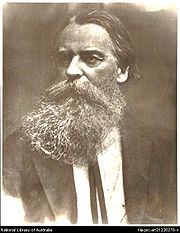|
|
|
|
| Thomas Baines: from Childhood to the grave |
|
| At the conclusion of the war in 1854 Baines returned to England, and was soon after his arrival, at the recommendation of our Council, appointed artist to the North- West Australian Expedition, under Mr. Augustus Gregory. During this arduous undertaking he distinguished himself and earned the approval of his leader and the Colonial Office by the zeal and ability with which he carried out a special mission with which he was entrusted, namely, a voyage in a schooner from the Victoria River to Java to procure fresh provisions for the Expedition, after their traverse by land from the Victoria to the Albert Rivers. |
 |
The large series of sketches in oil made by Baines during this, as well as the subsequent Zambesi Expedition, were afterwards divided between the Kew Museum and our Society. On the termination of the Expedition in 1856, Baines returned to England, and on revisiting his native town was presented with the freedom of the borough by the corporation.When the Zambesi Expedition, under Dr. Livingstone, was organised, early in 1858, Baines was selected to accompany it as artist and storekeeper.An unhappy disagreement with Mr. Charles Livingstone, the brother of the great traveller, led to Mr. Baines' retirement, much against his own will, and he proceeded to the Cape. |
|
His love of exploration was at this time as keen as ever, and having become well versed in the use of astronomical and surveying instruments, under the supervision of Sir Thomas Maclear, Astronomer Royal at the Cape, he accepted the invitation of his friend, Mr. Thomas Chapman, an ivory-trader, to accompany him on a journey from the south-west coast to the Victoria Falls of the Zambesi.
|
| An account of this journey was published by him in 1864 on his return to England, under the title of Explorations in South- West Africa ; being an Account of a Journey in 1861-2 from Walvis Bay to Lake Ngami and the Victoria Falls. Besides a complete route survey and very numerous sketches, Baines made on this journey a collection of objects of natural history. He spent several weeks at the Victoria Falls, making drawings and measurements; and published, besides the narrative just mentioned, a folio volume of coloured lithographs of this remarkable cataract |
|
| The years 1864-8 Baines spent in England, employing himself in bringing out the works above mentioned, lecturing, writing, and drawing illustrations for various periodicals. His industry was without limit. Early and late he was to be found in his painting-room, or at the desk, and his time and abilities were at the service of anyone who needed them, with or without payment; for among his most striking characteristics was an utter indifference to worldly considerations. At the end of the year 1868 he again went out to Africa, under engagement with a company to explore the goldfields of the Tati, recently discovered, or re-discovered, by Carl Mauch and Mr. Hartley. He succeeded in obtaining the friendship of Lobengula, the successor of the celebrated Mzilikazi, the paramount chief of the region in which lay the goldfields. From him he obtained valuable concessions for the company he represented ; but nothing came of all his toilsome journeys and successful diplomacy; the distances were too great, and the company had no capital. |
Baines was never reimbursed for his expenses, and had, on his return to Natal, to toil again as an artist to obtain a livelihood. The results of his explorations in the gold regions were, however, of considerable importance to geography. He mapped very carefully the country and the route thither from the capital of the Transvaal Republic, and wrote a description of the region, which is now about to be published under the editorship of his old and tried friend, Mr. H. Hall, of Cape Town. A reduction of his map was published in our Journal, vol. xli., in illustration of an abridgment of his journals by Dr. R. J. Mann. In 1873 our Council recognised the value of Baines' geographical services by presenting him with a testimonial gold watch. He undertook, subsequently, other journeys into the adjoining countries of South Africa, always mapping most carefully his routes and sketching scenery and people. After a visit to Port Elizabeth he planned a new journey, almost alone, to the gold district north of Tati, taking with him a small quartz-crushing machine, and had prepared all his outfit and waggons for the journey when he was struck down with the old enemy of so many African travellers—dysentery —at Durban, and died, as before stated, on the 8th May, 1875!
|
| |
| |
|
|
| If you feel this is not an
accurate profile and you have a more accurate one, or
you have a clarification , you can submit your version of the Profile here |
|
|
|
|
| |
|